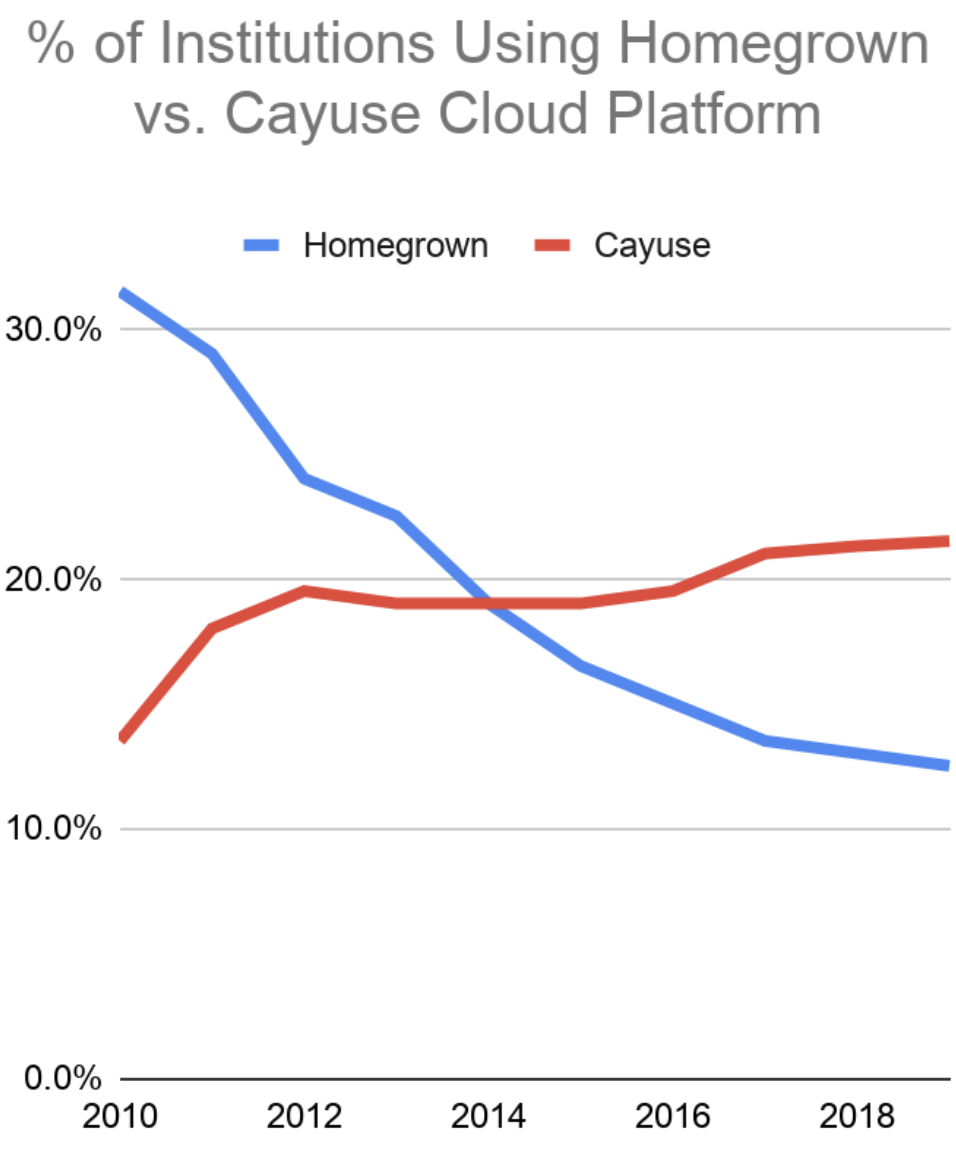by Adam Mertz, Cayuse VP of Marketing
Over the past decade, technology has dramatically changed grant management in higher education. But until now, no one has analyzed these major shifts. Market research firm LISTedTECH recently surveyed nearly 1,200 North American higher education institutions and developed the first-ever in-depth industry analysis. The report reveals several key trends:
- As homegrown and on-premise approaches to eRA have declined, cloud-based solutions have become more of the norm
- The emergence of broader, end-to-end platforms that enable control of all aspects of an institution’s research spectrum
- The increasing emphasis on easy integrations between grant management software and existing ERP systems in use at institutions
Let’s take a look at each of these key trends.
Homegrown and on-premise approaches declining, and cloud-based approaches becoming more of the norm
Many people perceive homegrown and on-prem software to be more customizable than cloud-based solutions. A decade ago, it’s probably accurate that home-grown and custom-built solutions that were on premise could be exactly customized to an institution’s processes, while cloud solutions were built to be configured and generally provided limited options to ensure upgradeability. Configuration, the thinking went, was inferior to customization because it gave the institution less power over the particulars of the software. However, advances in technology are challenging this belief. The report touches on this, noting, “The whole question of configuration versus customization may be completely moot as the current and new systems are evolving.”
Today, cloud software may actually be the better choice for three reasons:
- It takes less upkeep from an institution’s IT department.
- True cloud native (not just hosted) software easily scales, so if usage or users increase, there’s never a concern. As the current COVID-19 situation has led to a 100% work-from-home environment, this delta has suddenly become even more critical.
- Cloud software now can often support a variety of custom processes that previously weren’t possible.
I’ll provide an example to illustrate my third point since some may still find it hard to believe. Let’s say a university’s Office of Sponsored Projects has a custom workflow that requires special form logic and question paths dependent on form responses. With a customizable homegrown system, the IT department builds the office’s forms to match the workflow. This takes longer than it does with a vendor’s configurable, cloud-based solution, but it used to be considered worth it because it was custom-tailored to the office’s needs.
With Sponsored Projects (our software to manage the entire research lifecycle), users enjoy the same customization in a few minutes and clicks. Our smart forms can be completely customized to the institution’s workflow, so the result is the exact same as you’d get with a customized homegrown or on-prem solution, without all of the effort. But where the magic really comes in is when that process being supported by the software needs to be updated. With a homegrown solution or on-prem, it likely means kicking off a project with IT or outside consultants to update the software vs. going in and modifying the smart form in a few clicks.
The graphic, leveraging LISTedTECH report data, illustrates how homegrown systems are on the decline in favor of cloud-based platforms like Cayuse:

Over the course of the last month, when most research teams are working from home, the need for easy-to-use systems that are always available in the cloud has become more important than ever.
The emergence of broader, end-to-end platforms that enable control of all aspects of an institutions research spectrum
Higher ed institutions are beginning to see offerings that enable more control over the entirety of their research administration needs. This trend towards end-to-end software platforms and the benefits over point solutions has already been proven out across many other industries. Systems like CRMs were once just glorified contact databases that helped manage support cases, but now they’ve added capabilities to support sales-related processes, along with marketing-related use cases and needs. For example, social media engagement used to be handled by point solutions and now it’s a module within most CRM systems. In higher ed, this trend is just now being seen in the last couple years.
At Cayuse, we recognized this trend a few years ago and have been executing towards this vision in order to give research administrators more control over every aspect of the research processes they support. We believe this vision has been a key component to the growth we’ve experienced, as the LISTedTECH report highlights. Below is a visual pulled from the report that highlights active implementations among different vendors, with Cayuse standing alone in the upper right quadrant. (To see all other vendors, check out the report.)

Download the report to unlock competitor names
Increasing emphasis on easy integrations between grant management software and existing ERP systems
Today’s research world requires a new level of connectedness. LISTedTECH writes, “An important consideration when purchasing a grant system is the ease with which the grant management system integrates with the institution’s financial management system and human resources system.”
Nearly two-thirds of all ERP system implementations are either Ellucian Banner or Oracle PeopleSoft. These are tried and true ERP systems, but it is interesting to see how many vendors, even some of the bigger ones, are not as commonly seen at the same institution as these ERPs. Do they have challenges integrating? The report doesn’t go into detail here, but it would be a question on my mind if I were looking at vendors as part of a selection process. We were happy to see data in the report supporting our open ecosystem and integration approach, with many institutions who have chosen those systems also leveraging Cayuse. This was an area I personally dug into when I recently started at Cayuse to better understand, and was happy to see that Cayuse had successfully integrated with a variety of finance systems 50+ times, and over 175 times with HR systems like PeopleSoft, Banner, Lawson, and Workday. We still are continuing to push to make these integrations as turnkey as possible, because we understand how important this is to virtually every institution that partners with us.
This post was just a high-level look at a few trends I pulled out from the report: cloud-based software, end-to-end platforms, and easy ERP integrations. For more details and to read more of the in-depth analysis, you can get your free copy of the report with an .edu email address!


